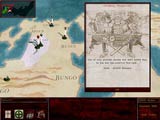 It’s a little astonishing that
nobody’s released a PC wargame on this period before. After all, sixteenth-century
Japan is probably the only period of Asian history that anybody in America knows anything
about—mostly through miniseries like Shogun and movies like Kurosawa’s Ran. Even
the terminology of the period—samurai, ronin, ninja, bushido, shogun—has made
its way into US vernacular in a way that, say, “salaryman” has yet to. No doubt
about it, there’s something compelling and colorful about the Sengoku Jidai period. Shogun: Total War is Electronic Arts’ attempt
to create a playable, fun, and historically realistic game based upon the period. And
though it has some interface problems and a steeper than necessary learning curve, for the
most part it succeeds. It’s a little astonishing that
nobody’s released a PC wargame on this period before. After all, sixteenth-century
Japan is probably the only period of Asian history that anybody in America knows anything
about—mostly through miniseries like Shogun and movies like Kurosawa’s Ran. Even
the terminology of the period—samurai, ronin, ninja, bushido, shogun—has made
its way into US vernacular in a way that, say, “salaryman” has yet to. No doubt
about it, there’s something compelling and colorful about the Sengoku Jidai period. Shogun: Total War is Electronic Arts’ attempt
to create a playable, fun, and historically realistic game based upon the period. And
though it has some interface problems and a steeper than necessary learning curve, for the
most part it succeeds.
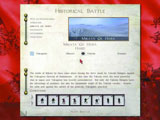 Shogun allows you three major gameplay options: custom,
historical, and campaign. In both the custom and historical modes, you’ll be limited
to fighting realtime battles on the 3D tactical map. That can be a lot of fun, but the
meat of Shogun is clearly the campaign game, which does an excellent job of combining a 2D
turn-based strategic game--in which you plan, build, and conduct strategic moves--with a
beautiful 3D realtime tactical game in which you fight out your battles. Shogun allows you three major gameplay options: custom,
historical, and campaign. In both the custom and historical modes, you’ll be limited
to fighting realtime battles on the 3D tactical map. That can be a lot of fun, but the
meat of Shogun is clearly the campaign game, which does an excellent job of combining a 2D
turn-based strategic game--in which you plan, build, and conduct strategic moves--with a
beautiful 3D realtime tactical game in which you fight out your battles.
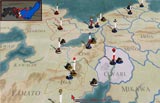 When you begin the campaign game, you’ll be asked to choose
from one of seven historical Japanese clans, each with a different strength. For example,
the Takeda have superior cavalry (as they did historically) and the Oda are handier with
early firearms. You’ll then begin to build your empire by taking over provinces that
provide koku (bushels of rice). Most of your income will derive from koku, but mines and
trade can also add some to your coffers. As in most strategy games, as you accrue money
you’ll be able to build new structures that offer new units and abilities. Some of
the structures and units are a hoot, too. For example, a Buddhist Temple allows you to
build Warrior Monks, who kick major butt in hand to hand; an armory awards an armor bonus
to any unit produced in the province, and allows you to train heavy cavalry and the
tank-like naginata. As your units fight in battles, they’ll gain more
“honor” which is essentially an experience bonus. Not every building type is
available in every province, and some provinces are renowned for particular types of
troops. If you produce them there, you get an honor bonus. Overall, resource management is
pretty intuitive (though the interface is a bit awkward) and it’s important, too, as
you’ll often be faced with tough decisions between training units for conquest and
building for upgrades. When you begin the campaign game, you’ll be asked to choose
from one of seven historical Japanese clans, each with a different strength. For example,
the Takeda have superior cavalry (as they did historically) and the Oda are handier with
early firearms. You’ll then begin to build your empire by taking over provinces that
provide koku (bushels of rice). Most of your income will derive from koku, but mines and
trade can also add some to your coffers. As in most strategy games, as you accrue money
you’ll be able to build new structures that offer new units and abilities. Some of
the structures and units are a hoot, too. For example, a Buddhist Temple allows you to
build Warrior Monks, who kick major butt in hand to hand; an armory awards an armor bonus
to any unit produced in the province, and allows you to train heavy cavalry and the
tank-like naginata. As your units fight in battles, they’ll gain more
“honor” which is essentially an experience bonus. Not every building type is
available in every province, and some provinces are renowned for particular types of
troops. If you produce them there, you get an honor bonus. Overall, resource management is
pretty intuitive (though the interface is a bit awkward) and it’s important, too, as
you’ll often be faced with tough decisions between training units for conquest and
building for upgrades.
The strategic game is played out on a
map that will remind many of the old MB Shogun and new Hasbro Samurai Swords game. As you
produce units, you group them into armies under the command of a general or you daimyo.
Unless you control ports, you can only move, Risk-like, one province a turn. This makes
for a rather stately pace that contrasts starkly with the games’ realtime 3D tactical
combat.
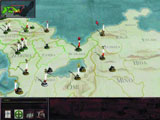 But though the strategic game isn’t as flashy as the
tactical battles, it’s just as complex. This is in part due to the enemy AI, which is
just ruthless. If you’re careless enough to leave a province ungarrisoned, you can
bet the enemy will strike. This is particularly the case with rebel and ronin forces, who
will seize any opportunity to make devastating end runs through your territory. Though a
smart player will usually win against the AI, it does make you pay for your mistakes. The
strategic game also has lots of little features that add to the game’s depth. For
instance, it’s very important to produce an heir and guard the dynastic
line—often it’s a lot easier to kill the enemy daimyo and his heirs than to
conquer his provinces. This can be done, by the way, in a variety of ways—you can
defeat him in combat, or you can decide to go the assassination route. If you wish, you
can train “black ops” units like ninjas and geishas (who excel in spying and
assassination) and shinobi (who spy and subvert your enemies’ peasants). But though the strategic game isn’t as flashy as the
tactical battles, it’s just as complex. This is in part due to the enemy AI, which is
just ruthless. If you’re careless enough to leave a province ungarrisoned, you can
bet the enemy will strike. This is particularly the case with rebel and ronin forces, who
will seize any opportunity to make devastating end runs through your territory. Though a
smart player will usually win against the AI, it does make you pay for your mistakes. The
strategic game also has lots of little features that add to the game’s depth. For
instance, it’s very important to produce an heir and guard the dynastic
line—often it’s a lot easier to kill the enemy daimyo and his heirs than to
conquer his provinces. This can be done, by the way, in a variety of ways—you can
defeat him in combat, or you can decide to go the assassination route. If you wish, you
can train “black ops” units like ninjas and geishas (who excel in spying and
assassination) and shinobi (who spy and subvert your enemies’ peasants).
The plot thickens when Dutch and
Portugese traders show up. Once contact is made with the gaijin, you can start to produce
firearms. While these can be a real asset on the battlefield, it comes at a price, as
these foreigners will not come forth with the goods until you convert from Buddhism to
Christianity. However, converting can cause a lot of problems if your populace is
Buddhist, and particularly if you have Buddhist monks in your army.
Though the strategic game is mostly
challenging and fun, it does have a few problems. First of all, the economic model is a
little mushy. It’s hard to tell how much you’re spending and how much you have
on hand--the game could definitely use a spreadsheet. And while the game does have a
diplomacy feature, it isn’t all that interesting. It mostly consists of making
alliances with other daimyo and hoping they’ll stay at peace with you until
you’re ready to attack them.
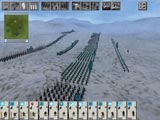 There are some interface problems, too--the strategic map is
minimalist in the extreme. It doesn’t show all the buildings each province has, which
means you have to go a menu deeper to find this information. In fact, you’ll have to
go to yet another to see buildings under construction in that province, and to yet another
one for units under construction, and yet another for units in your castle, and another
for units in the field. When you’ve got 20 or so provinces under your control, this
can be a pain. I’m still not sure why EA didn’t or couldn’t come up with an
interface that gives all this information on one screen, but it’s an annoyance I
could live without. There are some interface problems, too--the strategic map is
minimalist in the extreme. It doesn’t show all the buildings each province has, which
means you have to go a menu deeper to find this information. In fact, you’ll have to
go to yet another to see buildings under construction in that province, and to yet another
one for units under construction, and yet another for units in your castle, and another
for units in the field. When you’ve got 20 or so provinces under your control, this
can be a pain. I’m still not sure why EA didn’t or couldn’t come up with an
interface that gives all this information on one screen, but it’s an annoyance I
could live without.
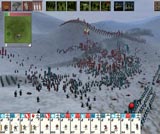 When you move your units into a province controlled by an enemy,
combat results and you fight the battle out on the 3D tactical realtime battlefield. The
interface between the tactical and the strategic games is excellent, and seems quite
organic—you never feel like you’re playing two different games. You may elect to
let the computer fight tactical battles for you, but this is almost always a bad
idea—unless you’re completely inept, you’ll do much better. When you move your units into a province controlled by an enemy,
combat results and you fight the battle out on the 3D tactical realtime battlefield. The
interface between the tactical and the strategic games is excellent, and seems quite
organic—you never feel like you’re playing two different games. You may elect to
let the computer fight tactical battles for you, but this is almost always a bad
idea—unless you’re completely inept, you’ll do much better.
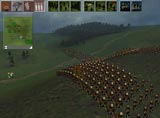 The 3D realtime battles are by far the most spectacular part of
Shogun—there’s no denying it, they look fabulous, and are very reminiscent of
Kurosawa’s epic battle scenes. Camera controls are very well-implemented, and you can
pan around the battlefield effortlessly. The terrain is particularly impressive. The
battlefields offer many features--from hills to woods to folds in the ground—that the
savvy general can use to his advantage. Weather effects also look very nice, and like
terrain they’re not just window dressing. Rain, for instance, is hell on firearms,
and fog will make it easier to to pull off ambushes—or be ambushed. Unlike the
terrain, units are 2D sprites. I suppose this was the only way to get thousands of troops
on screen, but it’s a little misleading, especially since the inside of the Shogun
box sports a graphic which implies that you’ll be able to zoom in on 3D units.
Nevertheless, the effect of all those troops marching in formation over the beautiful
terrain is nothing short of splendid. The 3D realtime battles are by far the most spectacular part of
Shogun—there’s no denying it, they look fabulous, and are very reminiscent of
Kurosawa’s epic battle scenes. Camera controls are very well-implemented, and you can
pan around the battlefield effortlessly. The terrain is particularly impressive. The
battlefields offer many features--from hills to woods to folds in the ground—that the
savvy general can use to his advantage. Weather effects also look very nice, and like
terrain they’re not just window dressing. Rain, for instance, is hell on firearms,
and fog will make it easier to to pull off ambushes—or be ambushed. Unlike the
terrain, units are 2D sprites. I suppose this was the only way to get thousands of troops
on screen, but it’s a little misleading, especially since the inside of the Shogun
box sports a graphic which implies that you’ll be able to zoom in on 3D units.
Nevertheless, the effect of all those troops marching in formation over the beautiful
terrain is nothing short of splendid.
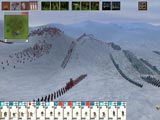 Combat is a lot of fun, too. Given the wide variety of
battlefields and the troops, no battle ever plays out quite the same. Troop types include
everything from samurai carrying spears and swords to calvary archers to armed peasants.
While each unit type has its strengths and weaknesses, this isn’t the
rock/paper/scissors sort of game some have suggested. Sure, matchups are important, but
timing and positioning are ultimately more decisive. There are plenty of tactical
options—you can array your units in different formations and give them aggressive or
defensive dispositions, and if you’re having trouble handling all the individual
units in your large armies you can always fall back on a plethora of preformatted
formations. You’ll need as much help as you can get, too, because the tactical AI is
excellent. It will lure your units into ambushes, try to hold the high ground, and
generally plays a smart game. Once an enemy general sent a unit of cavalry archers in open
formation parading just out of effective range of my archers, who wasted all their arrows
shooting at a pretty poor target. It was the sort of move you don’t usually see AI
make, and I was impressed. Combat is a lot of fun, too. Given the wide variety of
battlefields and the troops, no battle ever plays out quite the same. Troop types include
everything from samurai carrying spears and swords to calvary archers to armed peasants.
While each unit type has its strengths and weaknesses, this isn’t the
rock/paper/scissors sort of game some have suggested. Sure, matchups are important, but
timing and positioning are ultimately more decisive. There are plenty of tactical
options—you can array your units in different formations and give them aggressive or
defensive dispositions, and if you’re having trouble handling all the individual
units in your large armies you can always fall back on a plethora of preformatted
formations. You’ll need as much help as you can get, too, because the tactical AI is
excellent. It will lure your units into ambushes, try to hold the high ground, and
generally plays a smart game. Once an enemy general sent a unit of cavalry archers in open
formation parading just out of effective range of my archers, who wasted all their arrows
shooting at a pretty poor target. It was the sort of move you don’t usually see AI
make, and I was impressed.
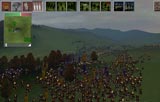 But for all the tactical game’s strengths, it does have a
few problems. Like the strategic game, the tactical interface can be clumsy. Grouping units together is essential in this game,
and unfortunately it takes a lot of keystrokes to do it, which can be frustrating.
It’s also difficult to set unit facing, which is crucial in a game like this, where
getting hit in the flank is usually lethal. But for all the tactical game’s strengths, it does have a
few problems. Like the strategic game, the tactical interface can be clumsy. Grouping units together is essential in this game,
and unfortunately it takes a lot of keystrokes to do it, which can be frustrating.
It’s also difficult to set unit facing, which is crucial in a game like this, where
getting hit in the flank is usually lethal.
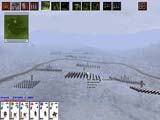 The clumsy interfaces aren’t the only problems with this
game. The tutorial gives you much less information than you need, and the manual is slim
and borderline awful. It took me a while to figure out when and how to combine armies, for
instance. I’ve had the game crash to the desktop a couple of times, especially when a
cinematic is playing, and you have to swap disks to play the campaign game. Multiplayer is
very weak. You can’t play the strategic game at all, and the EA\Play server was
difficult to log on to and dogged by lag. The custom games can be fun, but are poor
substitutes for a good scenario editor, and the historical game only offers six scenarios
and doesn’t include Sekigahara, which is like not including Waterloo in a game on the
Napoleonic Wars. The clumsy interfaces aren’t the only problems with this
game. The tutorial gives you much less information than you need, and the manual is slim
and borderline awful. It took me a while to figure out when and how to combine armies, for
instance. I’ve had the game crash to the desktop a couple of times, especially when a
cinematic is playing, and you have to swap disks to play the campaign game. Multiplayer is
very weak. You can’t play the strategic game at all, and the EA\Play server was
difficult to log on to and dogged by lag. The custom games can be fun, but are poor
substitutes for a good scenario editor, and the historical game only offers six scenarios
and doesn’t include Sekigahara, which is like not including Waterloo in a game on the
Napoleonic Wars.
With a better interface, manual, and
multiplayer implementation, this could have easily been a five-star game. As it stands,
it’s still a superior one. It’s colorful, fun, and historically accurate, and
the online “Way of the Daimyo” (which should have been included in print) is an
excellent introduction to the period. I’d recommend it without hesitation to strategy
gamers and anyone interested in samurai and ninjas (and who’s not?).
--Rick
Fehrenbacher |
